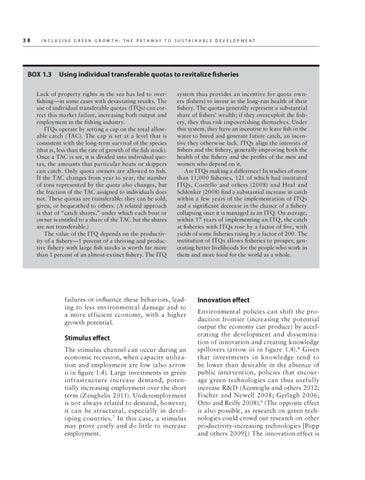38
I N C LU S I V E G R E E N G R O W T H: T H E PAT H WAY TO S U S TA I N A B L E D E V E LO PM E N T
BOX 1.3
Using individual transferable quotas to revitalize fisheries
Lack of property rights in the sea has led to overfishing—in some cases with devastating results. The use of individual transferable quotas (ITQs) can correct this market failure, increasing both output and employment in the fishing industry. ITQs operate by setting a cap on the total allowable catch (TAC). The cap is set at a level that is consistent with the long-term survival of the species (that is, less than the rate of growth of the fish stock). Once a TAC is set, it is divided into individual quotas, the amounts that particular boats or skippers can catch. Only quota owners are allowed to fi sh. If the TAC changes from year to year, the number of tons represented by the quota also changes, but the fraction of the TAC assigned to individuals does not. These quotas are transferable: they can be sold, given, or bequeathed to others. (A related approach is that of “catch shares,” under which each boat or owner is entitled to a share of the TAC but the shares are not transferable.) The value of the ITQ depends on the productivity of a fishery—1 percent of a thriving and productive fi shery with large fi sh stocks is worth far more than 1 percent of an almost-extinct fishery. The ITQ
system thus provides an incentive for quota owners (fi shers) to invest in the long-run health of their fishery. The quotas generally represent a substantial share of fishers’ wealth; if they overexploit the fishery, they thus risk impoverishing themselves. Under this system, they have an incentive to leave fish in the water to breed and generate future catch, an incentive they otherwise lack. ITQs align the interests of fishers and the fishery, generally improving both the health of the fishery and the profits of the men and women who depend on it. Are ITQs making a difference? In studies of more than 11,000 fi sheries, 121 of which had instituted ITQs, Costello and others (2008) and Heal and Schlenker (2008) fi nd a substantial increase in catch within a few years of the implementation of ITQs and a significant decrease in the chance of a fishery collapsing once it is managed as an ITQ. On average, within 17 years of implementing an ITQ, the catch at fi sheries with ITQs rose by a factor of five, with yields of some fisheries rising by a factor of 200. The institution of ITQs allows fisheries to prosper, generating better livelihoods for the people who work in them and more food for the world as a whole.
failures or influence these behaviors, leading to less environmental damage and to a more efficient economy, with a higher growth potential.
Stimulus effect The stimulus channel can occur during an economic recession, when capacity utilization and employment are low (also arrow ii in figure 1.4). Large investments in green infrastructure increase demand, potentially increasing employment over the short term (Zenghelis 2011). Underemployment is not always related to demand, however; it can be structural, especially in developing countries.7 In this case, a stimulus may prove costly and do little to increase employment.
Innovation effect Environmental policies can shift the production frontier (increasing the potential output the economy can produce) by accelerating the development and dissemination of innovation and creating knowledge spillovers (arrow iii in figure 1.4). 8 Given that investments in knowledge tend to be lower than desirable in the absence of public intervention, policies that encourage green technologies can thus usefully increase R&D (Acemoglu and others 2012; Fischer and Newell 2008; Gerlagh 2006; Otto and Reilly 2008).9 (The opposite effect is also possible, as research on green technologies could crowd out research on other productivity-increasing technologies [Popp and others 2009].) The innovation effect is
